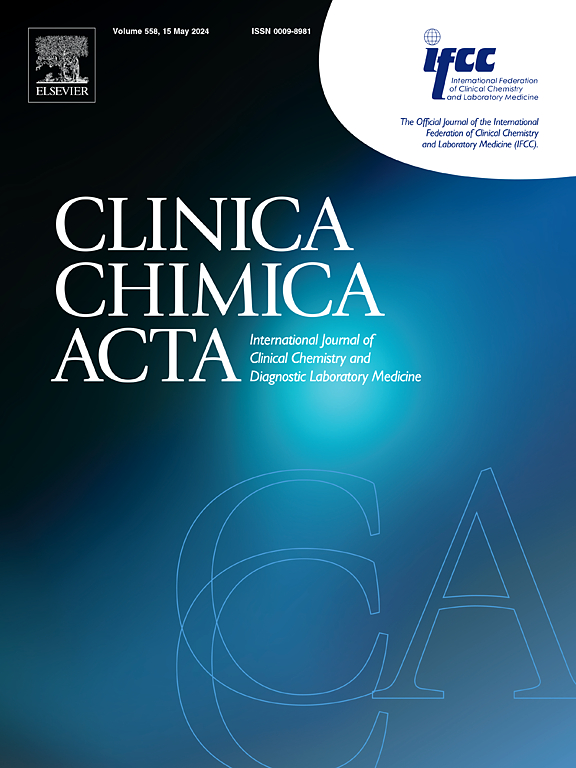基于适体体的电化学生物传感器用于孕酮检测:推进护理点诊断
IF 3.2
3区 医学
Q2 MEDICAL LABORATORY TECHNOLOGY
引用次数: 0
摘要
孕酮检测已成为生殖健康监测、临床诊断和环境分析的关键领域。传统的检测方法虽然准确,但往往需要复杂的实验室设置和延长的分析时间。电化学生物传感器通过提供商业上可获得的、高灵敏度和特异性的检测方法,已经改变了护理点诊断。生物传感器技术的进步满足了人们对快速、经济、准确的分析工具日益增长的需求,这些分析工具的功能超出了传统的实验室设置。在各种生物识别元件中,适体短单链DNA或RNA分子因其高特异性、可负担性和批间一致性而成为传统抗体和酶的有希望的替代品。电化学适体生物传感器(E-ABs)利用在金电极上自组装单层的适体序列,促进底物结合时有效的电子转移。这种机制能够实现快速和连续的信号转导,使E-ABs非常适合检测体液中的生物标志物,应用范围涵盖临床诊断和体内监测。将基于适配体的电化学生物传感集成到即时检测中,是向便携式、多路复用和经济高效的诊断解决方案迈出的重要一步。本文章由计算机程序翻译,如有差异,请以英文原文为准。
Aptamer-based electrochemical biosensors for progesterone detection: Advancing point-of-care diagnostics
Progesterone detection has emerged as a critical area in reproductive health monitoring, clinical diagnostics, and environmental analysis. While accurate, traditional detection methods often require complex laboratory setups and extended analysis times. Electrochemical biosensors have transformed point-of-care diagnostics by offering commercially accessible, highly sensitive, and specific detection methods. The advancement of biosensor technology addresses the growing demand for rapid, cost-effective, and accurate analytical tools that function beyond conventional laboratory settings. Among various biorecognition elements, aptamer short, single-stranded DNA or RNA molecules have emerged as promising alternatives to traditional antibodies and enzymes because of their high specificity, affordability, and batch-to-batch consistency. Electrochemical aptamer biosensors (E-ABs) utilize aptamer sequences tethered to a self-assembled monolayer on a gold electrode, facilitating efficient electron transfer upon substrate binding. This mechanism enables rapid and continuous signal transduction, making E-ABs well suited for detecting biomarkers in bodily fluids, with applications spanning clinical diagnostics and in vivo monitoring. The integration of aptamer-based electrochemical biosensing into point-of-care testing represents a significant step toward portable, multiplexed, and cost-efficient diagnostic solutions.
求助全文
通过发布文献求助,成功后即可免费获取论文全文。
去求助
来源期刊

Clinica Chimica Acta
医学-医学实验技术
CiteScore
10.10
自引率
2.00%
发文量
1268
审稿时长
23 days
期刊介绍:
The Official Journal of the International Federation of Clinical Chemistry and Laboratory Medicine (IFCC)
Clinica Chimica Acta is a high-quality journal which publishes original Research Communications in the field of clinical chemistry and laboratory medicine, defined as the diagnostic application of chemistry, biochemistry, immunochemistry, biochemical aspects of hematology, toxicology, and molecular biology to the study of human disease in body fluids and cells.
The objective of the journal is to publish novel information leading to a better understanding of biological mechanisms of human diseases, their prevention, diagnosis, and patient management. Reports of an applied clinical character are also welcome. Papers concerned with normal metabolic processes or with constituents of normal cells or body fluids, such as reports of experimental or clinical studies in animals, are only considered when they are clearly and directly relevant to human disease. Evaluation of commercial products have a low priority for publication, unless they are novel or represent a technological breakthrough. Studies dealing with effects of drugs and natural products and studies dealing with the redox status in various diseases are not within the journal''s scope. Development and evaluation of novel analytical methodologies where applicable to diagnostic clinical chemistry and laboratory medicine, including point-of-care testing, and topics on laboratory management and informatics will also be considered. Studies focused on emerging diagnostic technologies and (big) data analysis procedures including digitalization, mobile Health, and artificial Intelligence applied to Laboratory Medicine are also of interest.
 求助内容:
求助内容: 应助结果提醒方式:
应助结果提醒方式:


